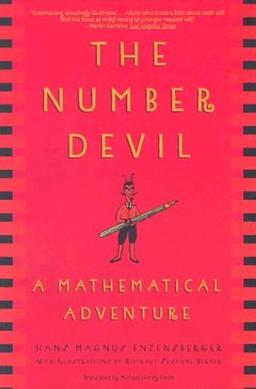The Number Devil facts for kids

The Number Devil: A Mathematical Adventure cover
|
|
| Author | Hans Magnus Enzensberger |
|---|---|
| Translator | Michael Henry Heim |
| Illustrator | Rotraut Susanne Berner |
| Cover artist | Rotraut Susanne Berner |
| Country | Germany |
| Language | German |
| Genre | Children's book |
| Publisher | Henry Holt and Company |
|
Publication date
|
1997 |
|
Published in English
|
1998 |
| Media type | Paperback/Hardcover |
| Pages | 261 |
| ISBN | 0-8050-6299-8 |
The Number Devil: A Mathematical Adventure (German: Der Zahlenteufel. Ein Kopfkissenbuch für alle, die Angst vor der Mathematik haben) is a book for kids and young adults. It explores the fun world of mathematics. Hans Magnus Enzensberger wrote it in German in 1997, and Rotraut Susanne Berner drew the pictures.
The story is about a young boy named Robert. He learns about math from a clever "number devil" called Teplotaxl. This happens over twelve dreams. Many people liked the book. Critics said it explained math well and was easy to understand. It uses colorful, made-up math words and cool ways to describe ideas. Because of this, it's a great book for anyone, young or old, who finds math tricky. The Number Devil was very popular in Europe. Michael Henry Heim translated it into English.
Story Summary
Robert is a young boy who doesn't like math much. School math often makes him feel bored or worried. He also has dreams that happen over and over, like falling down a never-ending slide. But one night, a tiny devil creature interrupts his sleep. This creature introduces himself as the Number Devil. Robert only knows him as the Number Devil at first. Later, he learns the devil's real name is Teplotaxl.
Over twelve dreams, the Number Devil teaches Robert many math ideas.
First Few Nights
On the first night, the Number Devil appears in a giant world. He introduces Robert to the number one. The next night, the Number Devil shows up in a forest where trees look like the number one. He explains why zero is so important. He also talks about negative numbers (numbers less than zero). Then, he introduces "hopping," which is a fun way to describe exponentiation (multiplying a number by itself many times).
On the third night, the Number Devil takes Robert to a cave. He shows him "prima-donna" numbers, which are also called prime numbers. These are special numbers that can only be divided by themselves and one without anything left over. Later, on the fourth night, Robert learns about "rutabagas" at a beach. This is a made-up word for square roots. A square root is a number that, when multiplied by itself, gives you the original number.
More Dream Adventures
After the fourth night, Robert can't find the Number Devil in his dreams for a while. But on the fifth night, Robert finds himself in a desert. There, the Number Devil teaches him about triangular numbers using coconuts. These are numbers that can form a triangle shape.
On the sixth night, the Number Devil explains Fibonacci numbers, which he calls "Bonacci numbers." He shows how these numbers appear naturally by counting brown and white rabbits as they have babies. By this dream, Robert's mom notices he's much more interested in math. Robert even starts going to bed earlier, hoping to meet the Number Devil again.
The seventh night takes Robert to a plain, white room. The Number Devil shows him Pascal's triangle. This is a special pattern of numbers arranged in a triangle. On the eighth night, Robert dreams he is in his school classroom. The Number Devil arranges Robert's classmates in many different ways. He teaches Robert about permutations (different ways to arrange things) and "vroom numbers," which are also called factorials.
Final Lessons
On the ninth night, Robert dreams he is sick in bed. The Number Devil appears next to him. He teaches Robert about "garden-variety numbers," which are also known as natural numbers (the counting numbers). He also talks about the strange idea of infinity (something that never ends) and infinite series (endless lists of numbers that add up).
Robert then finds himself at the North Pole. Here, the Number Devil introduces "unreasonable numbers," also known as irrational numbers. These are numbers that cannot be written as a simple fraction. He also explains parts of basic shapes, like "dots" (called vertices) and "lines" (called edges).
By the eleventh night, Robert is very interested in math. But he wonders if math ideas are always true. The Number Devil then teaches him about mathematical proofs. These are ways to show that a math idea is definitely true. The dream ends with the Number Devil showing Robert a complex proof for basic math.
On the twelfth and final night, Robert and the Number Devil get an invitation to Number Heaven. The invitation names the Number Devil as Teplotaxl. Robert's time with him is over. In Number Heaven, Robert learns about "imaginative numbers," also known as imaginary numbers. He also sees a strange shape called a Klein bottle. As they walk through Number Heaven, Teplotaxl introduces Robert to many famous math experts, like "Bonacci" (who is Fibonacci) and "Professor Singer" (who is Georg Cantor). The book ends with Robert back in his class, using all the new math knowledge he gained.
See also
 In Spanish: El diablo de los números para niños
In Spanish: El diablo de los números para niños


